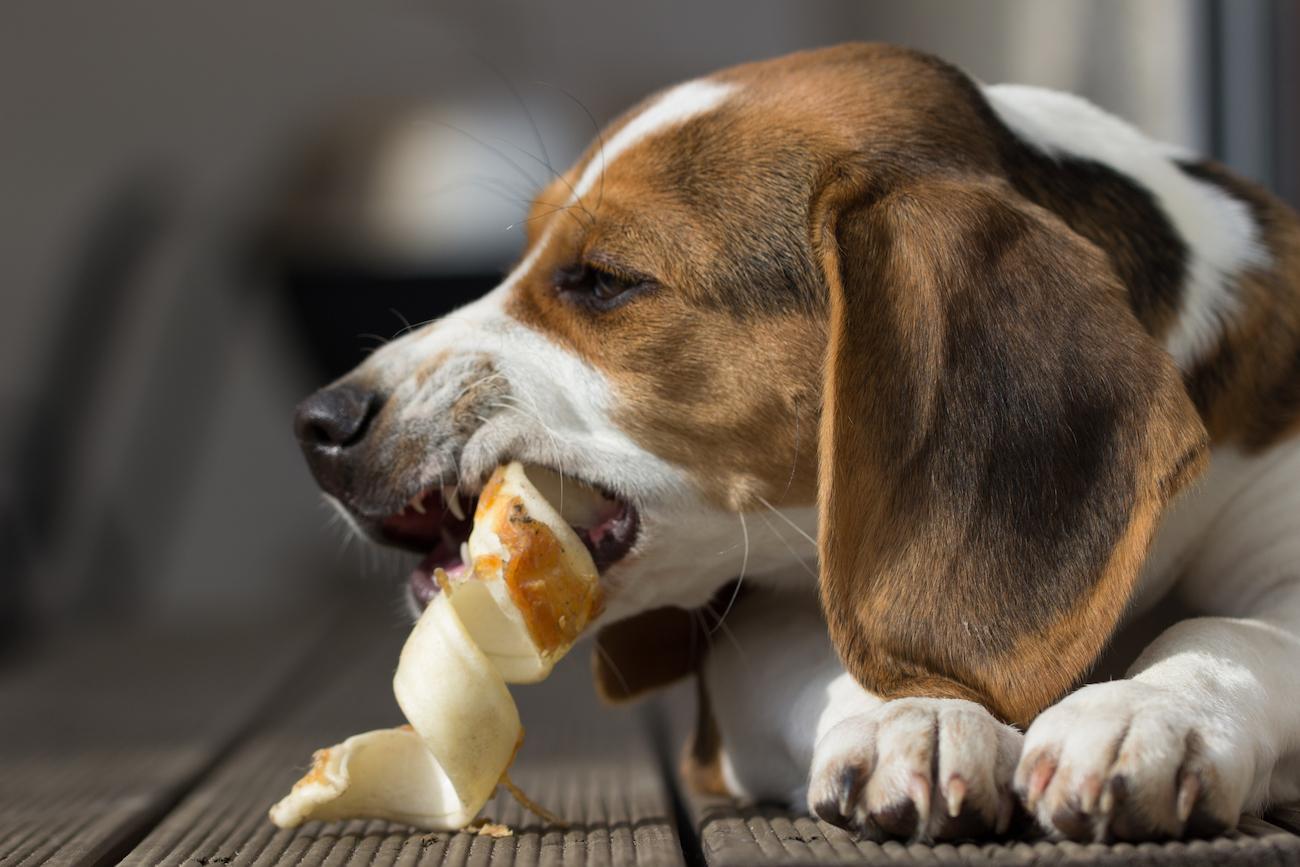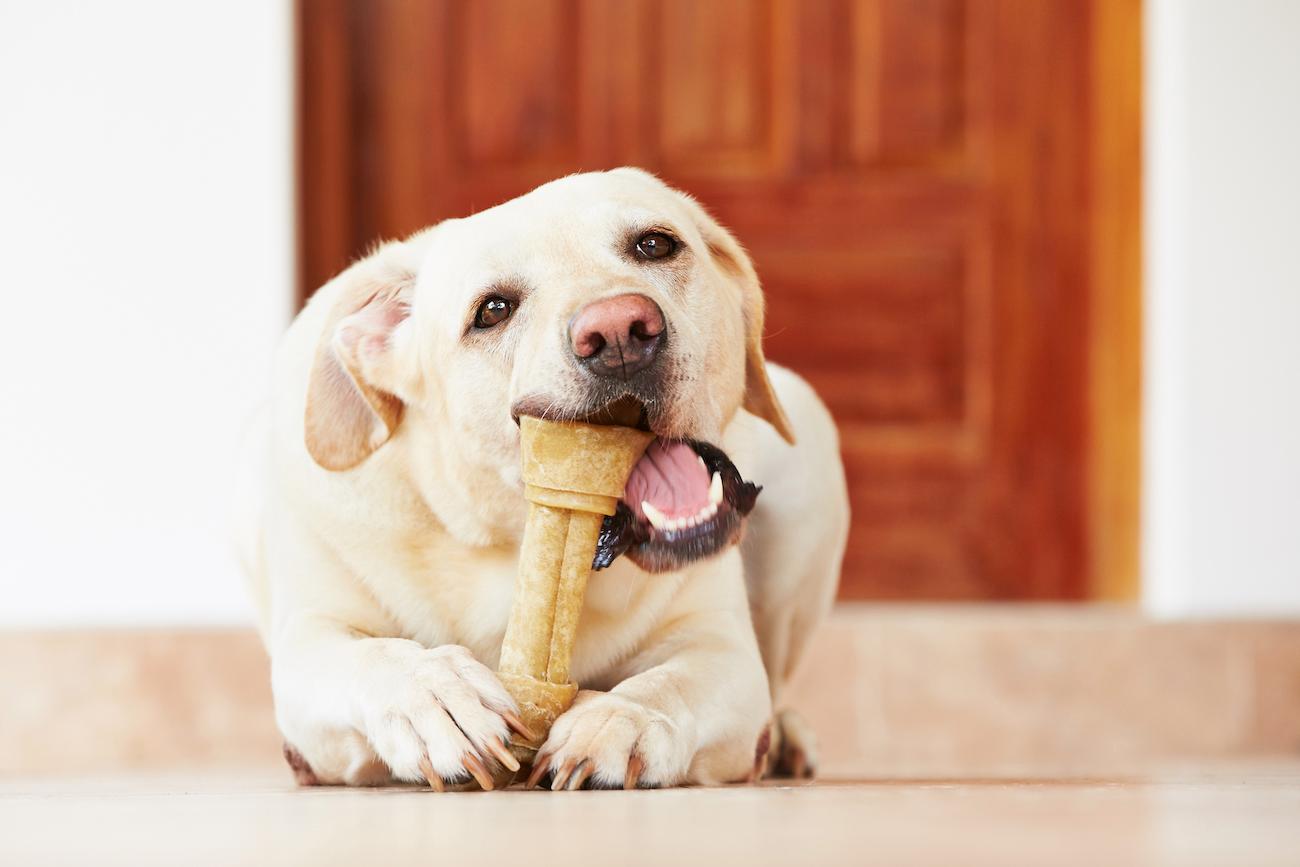Is Rawhide Bad for Dogs? Everything You Need to Know, Plus Safer Alternatives
Rawhide chews are popular dog treats — but are they safe?
Updated July 30 2019, 12:43 p.m. ET

What Are Rawhide Chews?
Rawhide chews are dog treats, given to dogs with hopes of cleaning their teeth and giving them something to chew. Rawhide is made from an animal’s “hide,” which is the skin of an animal that has been treated to become a product for humans to buy — mainly for leather, and also for rawhide chews. Rawhide chews are typically made from cows, as well as horses, buffalos, or deer.
Is Rawhide the Same as Beefhide?
A beefhide chew just refers to a rawhide specifically made from a cow’s skin. Similarly, porkhide chews are made from pig skin. Most commonly, rawhide chews are made from beefhide.
How Is Rawhide Made?
As explained by WebMD, rawhide is made from the second (inner) layer of an animal’s skin, while the outer skin is used to make leather. After the animal is slaughtered and the skin is removed from his or her body, it is then cleaned with detergent and degreasers, and sterilized using hydrogen peroxide or bleach, which helps remove the color and smell, as explained by Dog Rawhide Chews and Dogs Naturally Magazine.
As Dogs Naturally Magazine goes on to explain, hides are then coated with toxic chemical combinations, often via sodium sulphide liming, which removes any hair and fat that are still attached to the hide. More chemicals (sometimes even formaldehyde, which is a carcinogen) are then used to separate the two layers of a cow’s skin, and the outer layer is used to make leather, and the inner layer is kept to make rawhide.
Sometimes, the rawhide is ground up and then pressed into rawhide dog treats, according to WebMD. Other times, the entire hide is cut into various shapes using electric knives, and usually, flavors such as chicken or beef are added to the treat to make them more palatable, as per Dog Rawhide Chews.
Are Rawhide Chews Bad for Dogs?
While rawhides are given to dogs with the best of intentions, overall, they are not good to give to your dog. Rawhides pose a choking hazard to dogs, they can break dogs’ teeth, they can present digestive issues, they may introduce contamination, and more. The risks outweigh the benefits, and there are plenty of ways to give your dog proper oral care and a delightful chewing frenzy without rawhide.
Read on for more information on the specific risks of giving your dog rawhide, and for suggestions of safer alternatives.

Is Rawhide Good for Dogs’ Teeth?
Since dogs love to chew things, many pet parents give their dogs rawhide shoes to let them get out all those chewy tendencies — without risking their dogs chewing on more valuable things, like shoes that are laying around the house. Rawhide can also help keep your dog’s teeth clean. But on the flip side, rawhide can sometimes cause dogs to actually break teeth. As explained by Vet Street, there is a greater chance of this happening if you give your dog “pressed” rawhides, since they are denser and harder.
Can Rawhides Cause Choking?
Even though a rawhide seems like a pretty sturdy item, the more that your dog chews it, the more it breaks down. According to Embrace Pet Insurance, rawhides eventually get softer, longer, and stringier, meaning your dog will be able to bite off pieces and swallow them. However, rawhide pieces on the larger side pose a choking hazard, since they can get stuck in your dog’s throat. Warning signs that a dog has something lodged in their throat or may be choking include drooling, panicking, inability to swallow, and pawing at their mouth, as per Embrace Pet Insurance.
Can Rawhide Give Dogs Diarrhea, Gas, or Digestive Issues?
Rawhide is inedible — it’s only meant to be chewed, and not swallowed. As detailed by Embrace Pet Insurance, when dogs swallow pieces of rawhide, they sometimes swell up somewhere along your dog’s GI tract, and can cause digestive issues like vomiting, diarrhea, or pancreatitis. If your dog poops the rawhide pieces out, he/she should be OK, but if the pieces never come out, there could be a digestive blockage, which may require surgery.
This does not always happen — some dogs are able to swallow smaller pieces of rawhide and digest them with no issues. But since there are so many alternatives to rawhide on the market, it’s not worth the risk.
Do Rawhide Treats Have Bacteria or Toxic Chemicals?
According to WebMD, rawhide presents the risk of contamination to your dog, since the treat contains small amounts of toxic chemicals. Rawhide can also carry Salmonella or E. coli, just like all animal-based meat. Interestingly, those same risks can occasionally put humans who handle the treats at risk, WebMD claims.

Are Rawhides OK for Puppies?
Rawhides present the same risks to puppies as they present to fully-grown dogs. So if you’re worried about your puppy possibly choking or having digestive issues, you should avoid giving them rawhide chews.
Do Dogs Like Rawhide Bones?
If you no longer want to give your dog rawhide chews, you may also feel hesitant, because your dog loves them. But luckily, there are a slew of safer alternatives. It’s not just that your dog enjoys chewing rawhide, it’s that your dog loves chewing.
How to Avoid the Risks of Dogs Chewing Rawhide?
If you do choose to still give your dog rawhide chews, there are a few ways to reduce the risk of side effects. For one thing, always supervise your dog when he or she is chewing rawhide. Additionally, when the rawhide starts to stretch out or become stringy, take it away and give them a fresh one.
Safe Alternatives to Rawhide Chews for Dogs
With so many alternatives to rawhide chews on the market, there’s no need to put your dog at risk by giving him or her rawhide. Here are a few popular options: